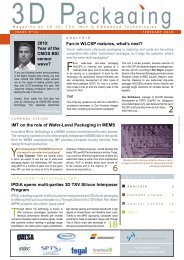3M & SUSS announce agreement on temporary wafer ... - I-Micronews
3M & SUSS announce agreement on temporary wafer ... - I-Micronews
3M & SUSS announce agreement on temporary wafer ... - I-Micronews
You also want an ePaper? Increase the reach of your titles
YUMPU automatically turns print PDFs into web optimized ePapers that Google loves.
J U L Y 2 0 0 9 i s s u e n ° 1 1<br />
N e w s l e t t e r o n 3 D I C , T S V , W L P & E m b e d d e d T e c h n o l o g i e s<br />
N E W S<br />
IBM fellow predicts end of Moore's Law: 3-D is next viable path!<br />
IBM Fellow Carl Anders<strong>on</strong>, who oversees physical design and tools in server divisi<strong>on</strong>, predicted during the recent<br />
Internati<strong>on</strong>al Symposium <strong>on</strong> Physical Design 2009 c<strong>on</strong>ference the end of c<strong>on</strong>tinued exp<strong>on</strong>ential scaling down of the size<br />
and cost of semic<strong>on</strong>ductors.<br />
The end of the era of Moore's Law, Anders<strong>on</strong><br />
declared, is at hand. Carl observed that like the<br />
railroad, automotive and aviati<strong>on</strong> industries before it,<br />
the semic<strong>on</strong>ductor industry has matured to the point<br />
that the pace of c<strong>on</strong>tinued innovati<strong>on</strong> is slowing. A<br />
generati<strong>on</strong> or two of c<strong>on</strong>tinued exp<strong>on</strong>ential growth<br />
will likely c<strong>on</strong>tinue <strong>on</strong>ly for leading-edge chips<br />
such as multicore microprocessors, but more<br />
designers are finding that everyday applicati<strong>on</strong>s do<br />
not require the latest physical designs, Anders<strong>on</strong><br />
said. C<strong>on</strong>sequently, Moore's Law--halving of the<br />
dimensi<strong>on</strong>s and doubling of speed of chips every 18<br />
m<strong>on</strong>ths--will run out of steam very so<strong>on</strong>.<br />
Only a few high-end chip makers today can even<br />
afford the exorbitant cost of next-generati<strong>on</strong><br />
research and design, much less the fabs to build<br />
them. Anders<strong>on</strong> cited three next-generati<strong>on</strong><br />
technologies that were still <strong>on</strong> the fast track for<br />
exp<strong>on</strong>ential growth: optical interc<strong>on</strong>nects, 3-D chips<br />
and accelerator-based processing. He predicted<br />
that rack-to-rack optical interc<strong>on</strong>nects will become<br />
comm<strong>on</strong>place, with chip-to-chip optical c<strong>on</strong>necti<strong>on</strong>s<br />
<strong>on</strong> the same board coming so<strong>on</strong>. But Anders<strong>on</strong> said<br />
<strong>on</strong>-chip optical signaling remains years away. He<br />
predicted that stacked DRAM dies would be the first<br />
to go 3-D.<br />
Texas Instruments gets a WL-CSP IC design win in latest Apple's iPod<br />
shuffle<br />
Chipworks Inc. recently had the chance to open Apple new iPod's shuffle device and revealed that TI got a high volume<br />
design win with a WLCSP packaged c<strong>on</strong>troller IC located in the headph<strong>on</strong>e cable.<br />
The new iPod shuffle has caused quite the<br />
“tempest in a teapot” over the last couple of<br />
weeks with the knowledge that the iPod c<strong>on</strong>tains<br />
no c<strong>on</strong>trols in the main body, <strong>on</strong>ly in the headph<strong>on</strong>e<br />
cable. And standard headph<strong>on</strong>es will not work with<br />
the iPod. Early speculati<strong>on</strong> suggested that it was a<br />
DRM chip, which clearly would be a very, very bad<br />
thing. Fortunately this has been refuted by Apple,<br />
and it is just a proprietary c<strong>on</strong>trol chip. Apparently<br />
part of a “made for iPod” licensing program that will<br />
incur additi<strong>on</strong>al charge to manufacturers wanting<br />
to make headph<strong>on</strong>es for the iPod. So, it’s just a<br />
bad thing. Obviously some circuitry is required to<br />
c<strong>on</strong>trol the iPod, and if you have no interface with<br />
the iPod, it has to be in the cable somewhere. One<br />
l<strong>on</strong>g-shot rumour is that the chip actually c<strong>on</strong>tains<br />
a microph<strong>on</strong>e. As Apple does sell headph<strong>on</strong>es with<br />
microph<strong>on</strong>es, it’s just possible that they are using the<br />
same device and activating the microph<strong>on</strong>e through<br />
software. So I thought I would throw our labs at this<br />
part and take a peek at what is inside this chip.<br />
The packaging is actually pretty unusual. It is a<br />
<strong>wafer</strong> level chip-scale bare die assembly, where<br />
the die has an RDL (metal redistributi<strong>on</strong> layer) and<br />
solder balls directly flip chipped to the board. The<br />
die marking is a laser marking <strong>on</strong> the back of the<br />
silic<strong>on</strong> die. Here is the die “undressed.” . It’s a small,<br />
1.35 mm x 0.85 mm, die made by Texas Instruments<br />
with die markings of CDPS3271C. The die markings<br />
clarify the part number, which is actually a typical TI<br />
TI's c<strong>on</strong>troller IC die “undressed” in a WLCSP package (Pictures courtesy of Chipworks Inc.)<br />
date code. The 8x represents the year and m<strong>on</strong>th,<br />
and the next four characters are the lot code.<br />
Therefore, our three parts were made in September<br />
’08 (89), October ’08 (8A), and December ’08 (8C).<br />
Taking a peek at it down the microscope, it looks like<br />
it is fabricated with a three metal BiCMOS process,<br />
likely 0.25 µm or 0.18 µm. There is not really a lot<br />
of circuitry <strong>on</strong> the die, but then again how much is<br />
really needed to relay the butt<strong>on</strong> commands to the<br />
processor chip – just the volume c<strong>on</strong>troller and the<br />
interface for the capacitive sensors <strong>on</strong> the back of<br />
the board.<br />
www.chipworks.com<br />
R3Logic is awarded key patent for 3D EDA tools<br />
R3Logic, world leader in design tools for 3D integrated circuits <str<strong>on</strong>g>announce</str<strong>on</strong>g>s that it has been granted US patent #7,526,739<br />
for “Methods and systems for computer aided design of 3D integrated circuits”.<br />
The patented inventi<strong>on</strong> comprises both the<br />
method of defining a 3D technology file that<br />
can incorporate <strong>on</strong>e or more 2D <strong>wafer</strong> technologies<br />
corresp<strong>on</strong>ding to different tiers in a 3D stack, and that<br />
of defining a 3D hierarchical structure for functi<strong>on</strong>al<br />
blocks within a 3D system. A key advantage to the<br />
3D technology file structure is that design kits and<br />
libraries for existing 2D processes do not have to be<br />
modified in any way to be used in a 3D design. It<br />
has been a fundamental assumpti<strong>on</strong> for the last 25<br />
years in EDA tools that <strong>on</strong>e chip corresp<strong>on</strong>ds to <strong>on</strong>e<br />
technology. As a result, designers who have tried to<br />
use existing 2D EDA tools to build 3D circuits have<br />
been forced to resort to gimmicks such as renaming<br />
design layers or creating multiple copies of standard<br />
cell libraries. Another drawback to current 2D tools<br />
is that there is no noti<strong>on</strong> of a 3D hierarchy and thus<br />
no way to build IP libraries for 3D. An example of a<br />
stand-al<strong>on</strong>e 3D functi<strong>on</strong>al unit would be an address<br />
decoder for a stacked memory device. These<br />
patented methods are fundamental to all of the 3D<br />
design tools developed by R3Logic. Being able to<br />
manage multiple design libraries and to properly<br />
handle IP blocks that reside <strong>on</strong> more than <strong>on</strong>e tier<br />
is crucial to 3D system design, whether at the circuit<br />
layout or at the system architecture level.<br />
www.r3logic.com<br />
Printed <strong>on</strong> recycled paper<br />
13
















